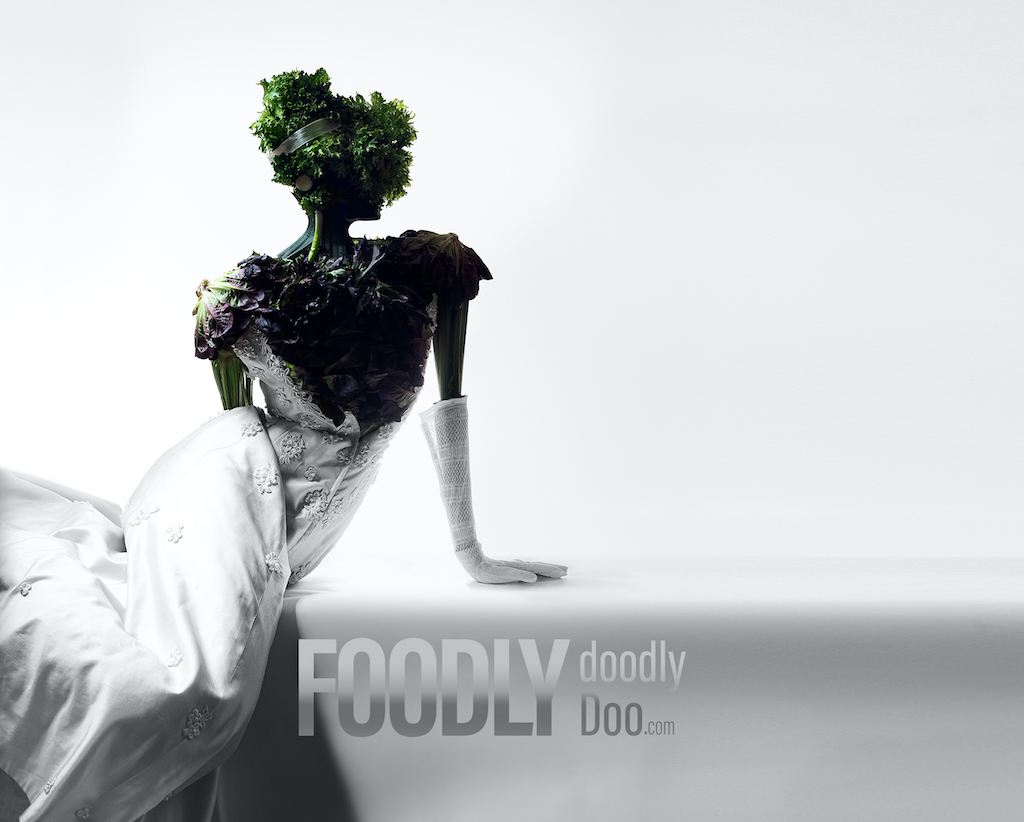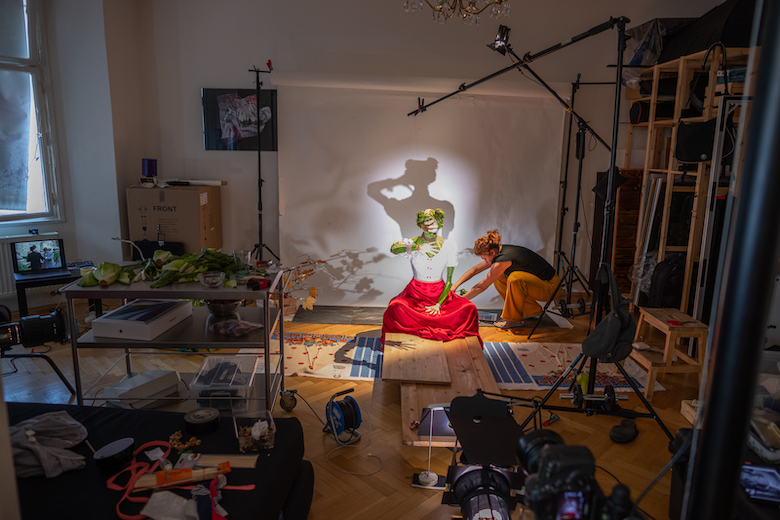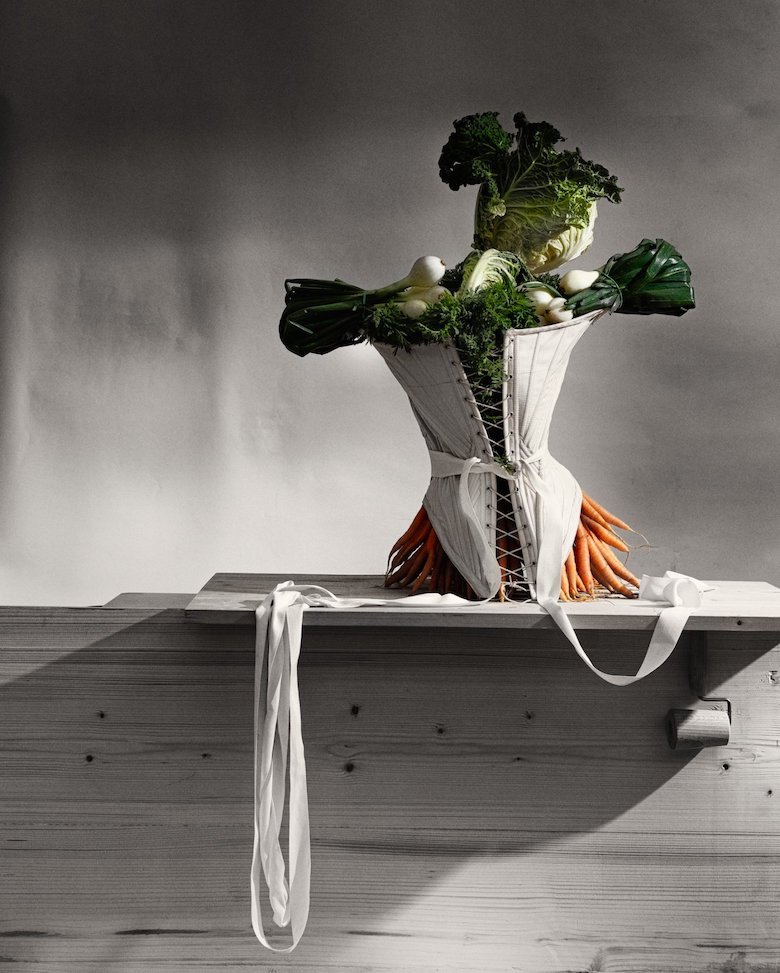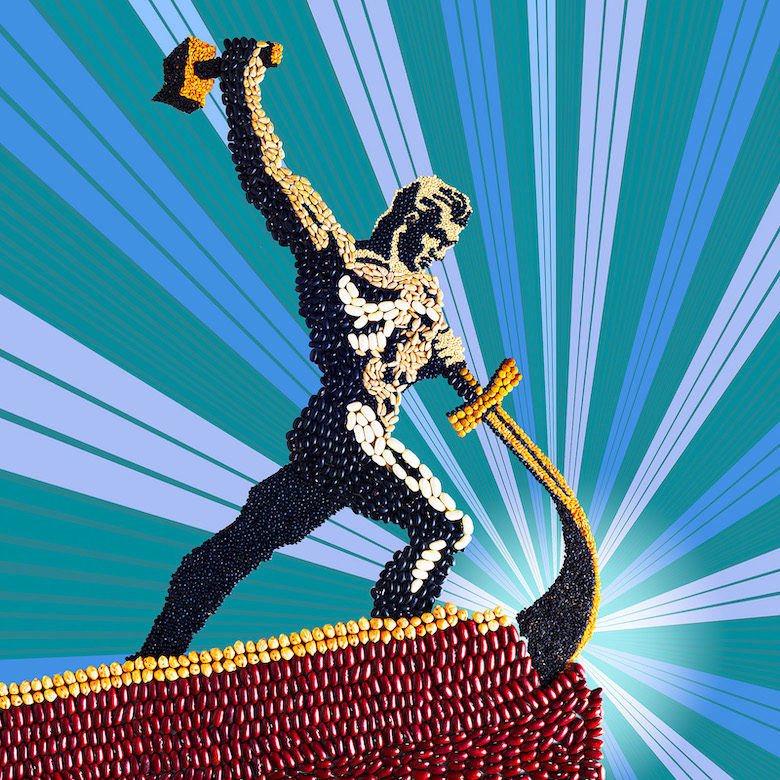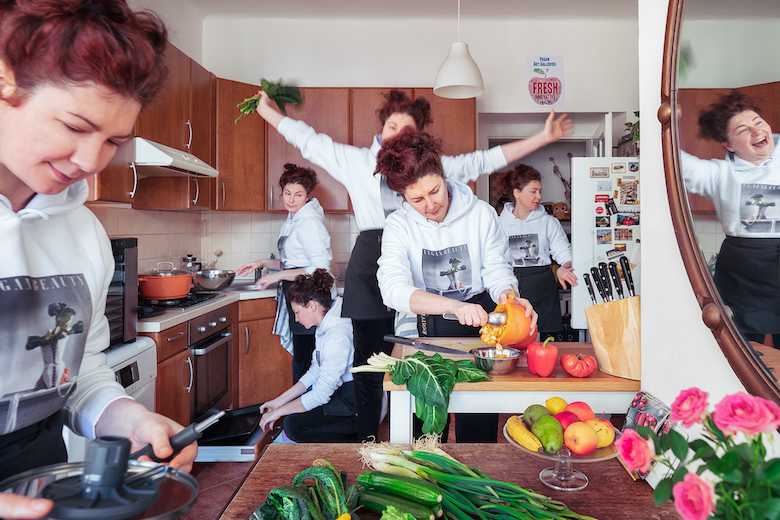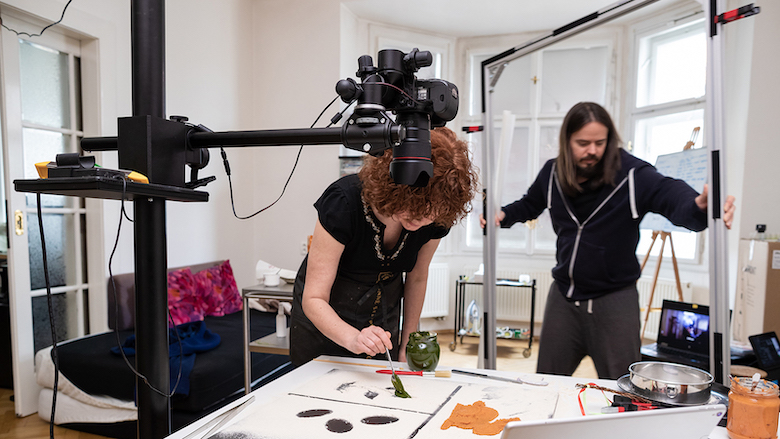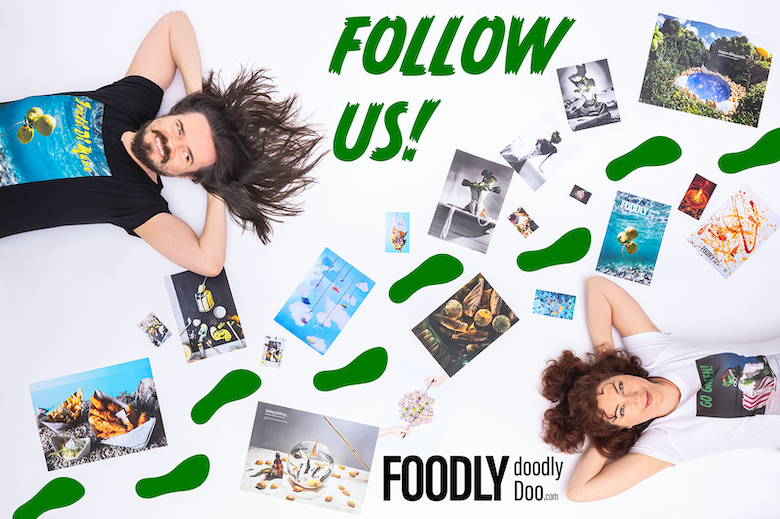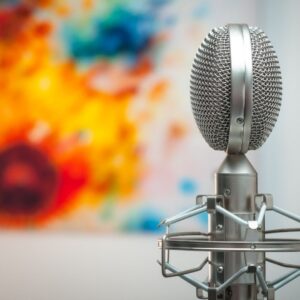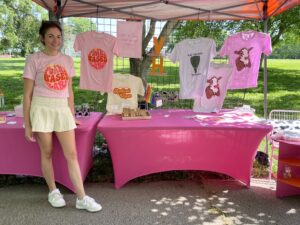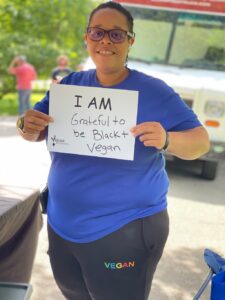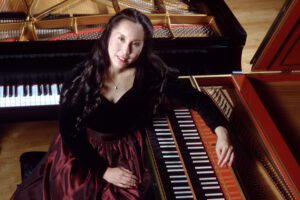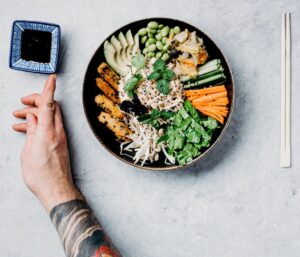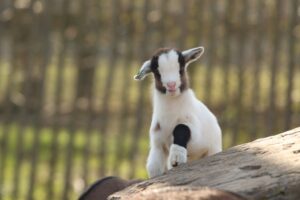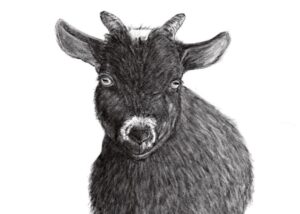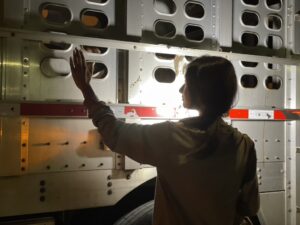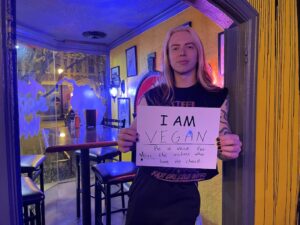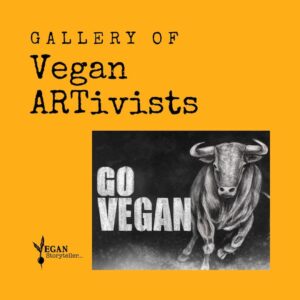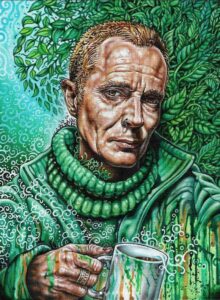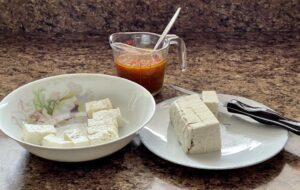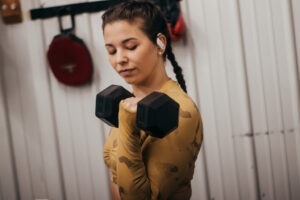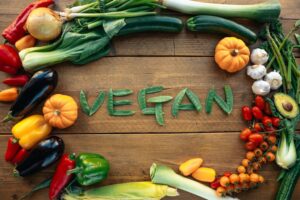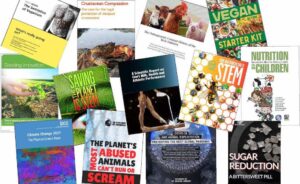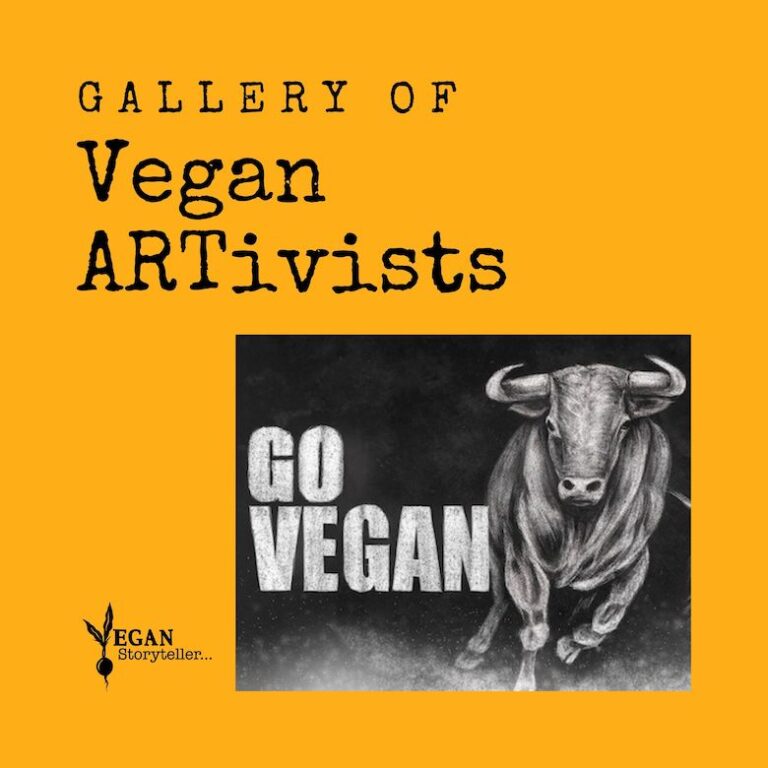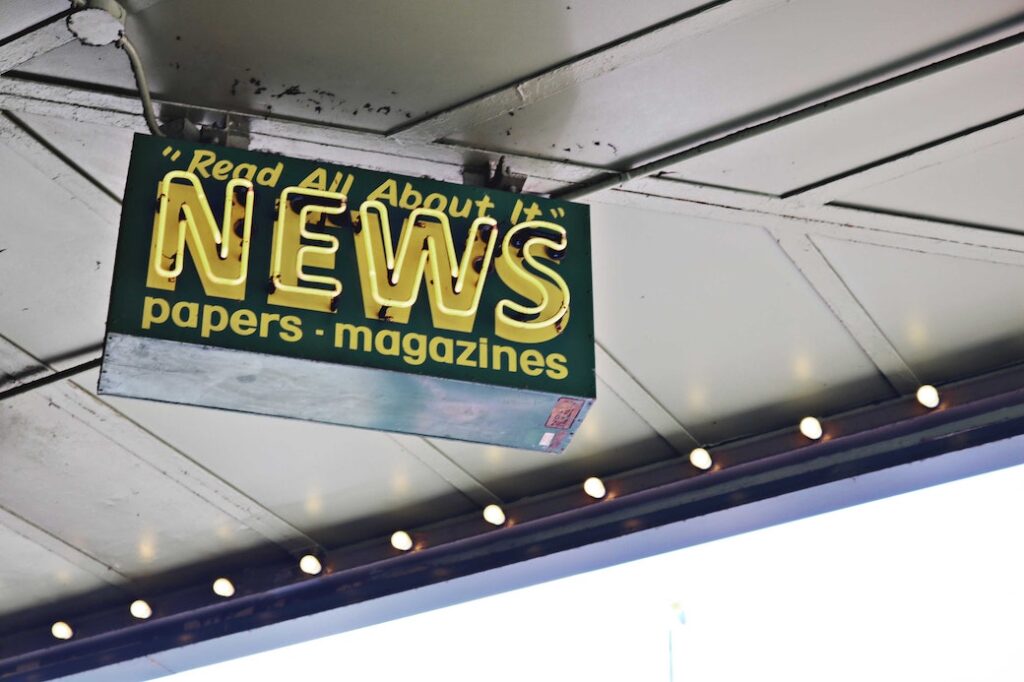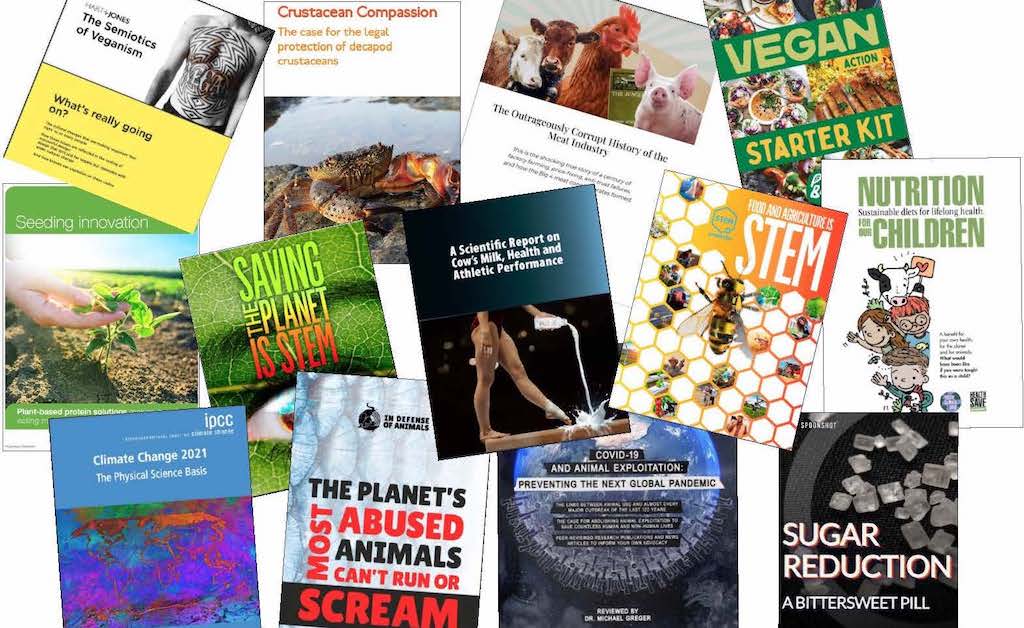Vegan food photographer Jan Prerovsky is showing the world that vegetables can be glamorous. With a camera in his hand and an eye for food and fashion, his photos of kale and other vegetables stand out as stars in his Horst P. Horst-style compositions. His photography puts the focus on each vegetable where it belongs — center stage!
Jan’s business partner Ellen Prerovsky is a dressmaker and vegan food stylist. She designs the make-up, hair, and signature wardrobes for Jan’s green models. She also creates set designs for stop motion animation videos.
We want our creations to entertain people and show them that veganism opens up a colorful and whole new delicious world. Welcome to our playground!
Ellen Prerovsky Tweet
TABLE OF CONTENTS
Vegan food photographer and vegan food stylist bring vegetables to life
Vegetables take center stage through Jan’s lens as a vegan food photographer
Glamorous images of vegan food command attention
Foodly Doodly Doo’s sculpted vegetables grace the covers of vegan magazines
Transition to a vegan lifestyle for the animals and environment
Health benefits and personal gains of going vegan
Jan Prerovsky: from tabloid photographer to vegan food photographer
Experimenting with digital technology
Doors open to travel and food photography
Self-taught photographer
Ellen Prerovsky: from dressmaker to vegan food stylist
Collaborating to create a fashion museum
Fashion museum blends Jan’s political science education with Ellen’s skills as a dressmaker
Filling the void with vegan food styling after fashion museum closes
Finding inspiration everywhere for vegan food styling and vegan photography
Dipping into the dream box to bring something new to life
Where art and veganism meet
1. Still Lifes inspired by the Old Masters: vegan food photography series
2. When Fashion Meets Food: vegan food photography series
3. Vegan Propaganda posters: vegan food photography series
4. Fun with recipes: vegan food photography series
5. Stop-motion animation: vegan food video production series
6. Here’s how we did it: behind-the-scenes vegan photography series
Creative sanctuary for two vegan artists
Milestones and future vegan projects
Learning from vegetables: educational video series in planning stages
Promoting veganism positively through play
Follow Foodly Doodle Doo
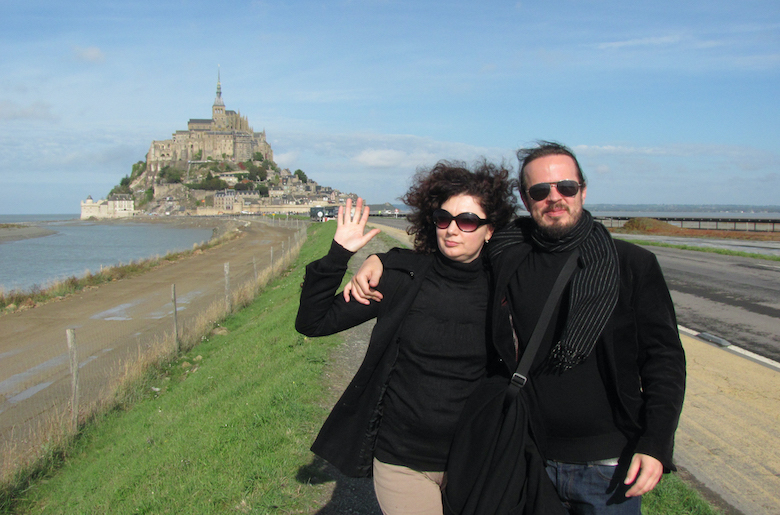
Photo by Jan Prerovsky, Foodly Doodly Doo
A vegan food photographer and vegan food stylist combine talents to bring vegetables to life
Jan and Ellen characterize what it means to be a visionary team. They have the ability to see what others don’t even know exists.
The two visionaries met in Prague 18 years ago and have been working together ever since, creating and photographing 3-D models of vegetables to advocate the vegan lifestyle and promote healthy eating. They married in 2018 and gave birth to the exciting multi-media production brand Foodly Doodly Doo, where they turn vegan food into a dream world of luxury.
Ellen and Jan are passionate about veganism and creativity. The vegan food photographer and vegan food stylist love working together in the vegan food photography industry, shooting for clients, developing concepts, and producing videos. They like finding new ways to make designs stand out for clients who want something different from what’s already available.
“We want our creations to entertain people and show them that veganism opens up a colorful and whole new delicious world. Welcome to our playground!” Ellen said.
Vegetables take center stage through Jan's lens as a vegan food photographer and Ellen's creative hands as a dressmaker and vegan food stylist
The goal of Foodly Doodly Doo is to make plant-based nutrition exciting and appealing, especially vegetables.
“Vegetables are amazing. Sadly, they are a forgotten food group. We think it’s time to shine a light on veggies and remind everyone how great they are so people eat them instead of meat,” Jan said.
Giving vegetables new status as a fashionable food is what Jan wants his vegan photography to do and what Ellen wants her vegan food styling to accomplish. However, they realize there is a hurdle to overcome because people want to see more than just vegetables on their cell phones and computer screens. They want to see other people.
To overcome the barrier of not showing people in their media productions, the two vegan food artists transform vegetables into human-like figures who live the good life hanging out with friends and having fun.
“We sculpt vegetables, dress them up in costumes, and give them personalities and stories so they are more than just vegetables. We turn nutrients into fashionable superstars,” Ellen said.
Glamorous images of vegetable models command full attention at Foodly Doodly Doo
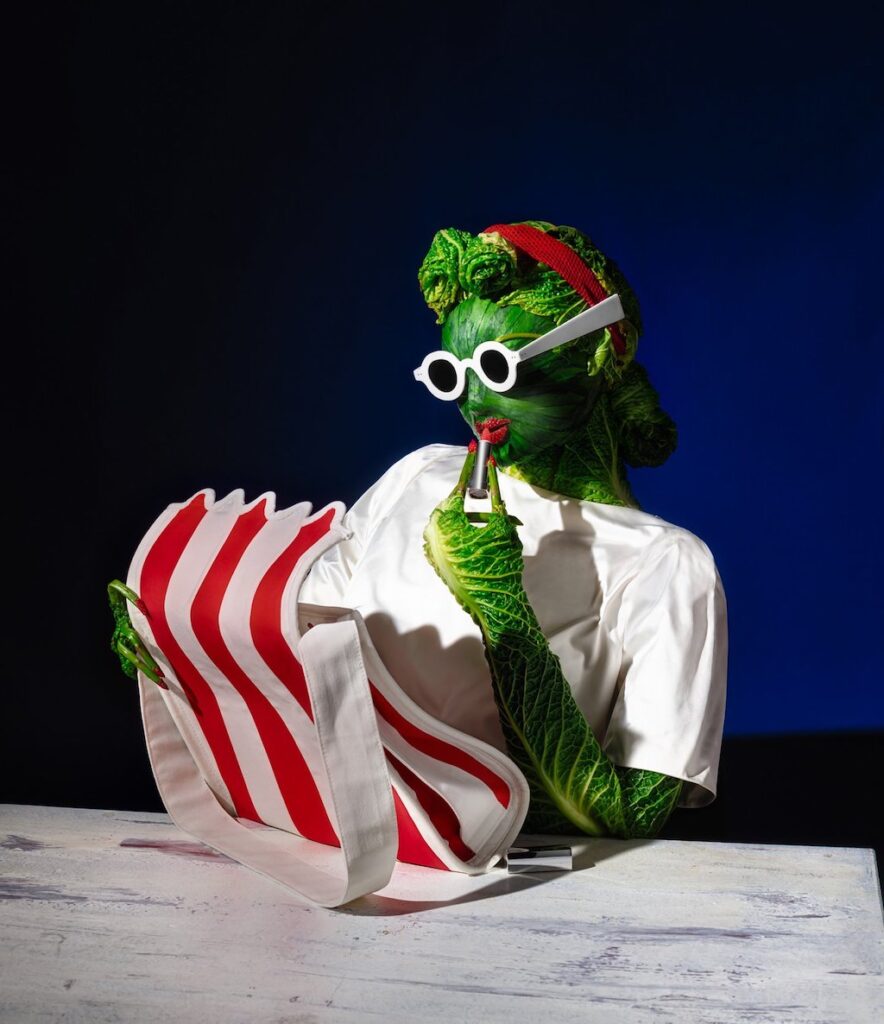
Photo by Jan Prerovsky, Foodly Doodly Doo, modeled after Horst P. Horst Vogue cover 1939
You know that feeling when you see a face on the cover of a glamor magazine that enchants you and makes your heart skip a beat? That’s what Ellen and Jan do with vegetables; they turn them into captivating images that command attention.
The collection of elegant and dreamy, comical, touching, and poignant designs at Foodly Doodly Doo take people on journeys through the vegan food world. Each recipe, photograph, and video has its own story to tell and adventure to follow.
A cauliflower family enjoys sunbathing on a beach in France, for example, while happy pears deep sea dive in the Aegean Sea. Foodly Doodly Doo’s baked apples soar into outer space and a lettuce fashion model draped in vintage lace lounges elegantly before the camera, just the way we would like to see ourselves sometimes.
We sculpt vegetables, dress them up in costumes, and give them personalities and stories so they are more than just vegetables. We turn nutrients into fashionable superstars.
Ellen Prerovsky Tweet
Foodly Doodly Doo's sculpted vegetables grace the covers of vegan magazines
Jan and Ellen merge fashion and food to create images with elegance, style, and glamor, drawing inspiration from their own ingenious minds and the iconic 20th century German-American fashion and portrait photographer Horst P. Horst.
Vegan magazines like World Vegan Magazine feature their beautiful green models, and Foodly Doodly Doo’s animated internet series Behind-the-Scenes highlights their sculpted creations. In this way, the images help us think more deeply about the foods we eat and why we eat them. Vegan food art at Foodly Doodly Doo serves as message boards for a more connection-based society.
Transition to a vegan lifestyle for the animals and environment
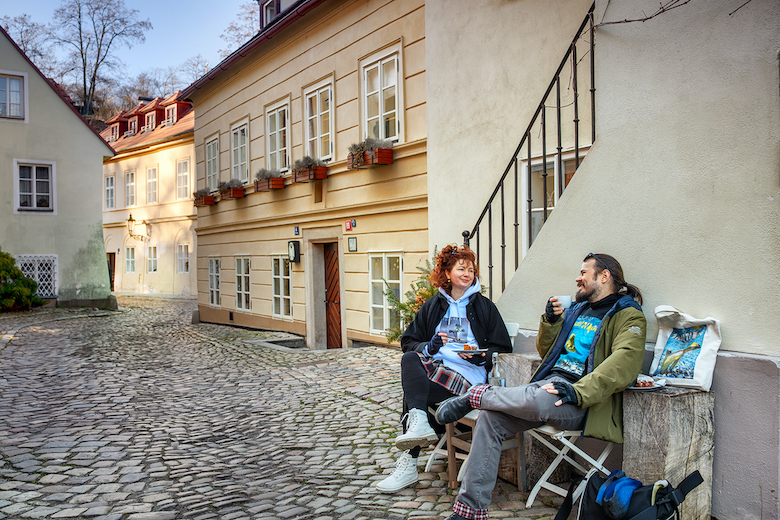
Photo by Jan Prerovsky, Foodly Doodly Doo
Jan and Ellen transitioned to a vegan lifestyle in 2018 because they wanted to live a cruelty-free lifestyle and contribute to a sustainable future.
“Ellen and I are both very curious and open to new things. Some years ago, friends of ours talked about the benefits of being vegan. Intrigued by what we heard, we did some research and decided that going plant-based was the only sensible decision we could make for animals, the environment, and our health,” Jan said.
Scientific evidence is clear — if you want to do something to improve the climate catastrophe, switching to a plant-based diet is the fastest, easiest, and most effective contribution any of us can make.
Vegan diets are growing in popularity as people become more aware of the harmful effects of the meat and dairy industries on animal welfare, human health, and the environment.
Health benefits and personal gains of going vegan
The personal gain of going vegan is huge. Randomized control studies show that a vegan diet offers various health benefits, ranging from weight loss and reduced blood sugar to prevention of heart disease, cancer, and premature death. As for Jan and Ellen, they say they have never felt better.
“We are in our best shape ever and have never been more fit. We have never felt better than we do now, after going vegan. It all begins with what you put on your plate,” Jan said.
Today, Jan and Ellen champion whole foods and ethical living. They model it in their daily lives as individuals and through the vegetable models they sculpt at Foodly Doodly Doo.
The vegan food photographer and vegan food stylist are proving that plant-based cuisine is just as beautiful, nutritious, and appetizing as any other kind of dining experience. Their art is an encouraging and empowering statement that vegetables should be at the center of our plates.
Jan Prerovsky: from tabloid photographer to vegan food photographer
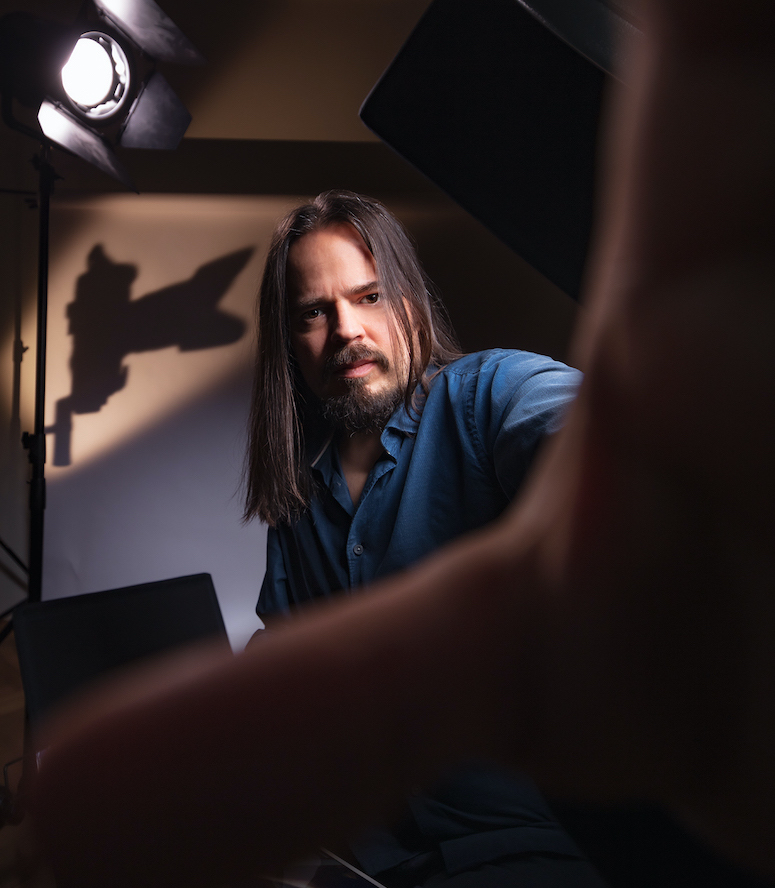
Photo by Jan Prerovsky, Foodly Doodly Doo
Specializing in vegan food photography wasn’t Jan’s original plan. He started his career as a tabloid photojournalist.
Jan grew up in Munich, Germany, after his family emigrated from Czech Republic. While enrolled as a political science major at the Ludwig Maximilian University, he decided to pursue a career in photojournalism.
He quit the university before getting his degree and went to work for Germany’s largest tabloid press agency (Schneider-Press), where he followed celebrities around the world, taking their pictures and writing about them. It was an exciting but unfulfilling career. The work left him feeling depleted.
Jan was never really interested in the yellow press/tabloids. He was better with pictures than words and wanted to explore other fields of photography. He quit the tabloids and focused on serious photo reportage as well as experimental projects. He worked for a while with the German press agency and did freelance work.
Experimenting with digital technology
Technology had gone digital and Jan found himself experimenting with stop motion and time lapse movies. As an experiment with the new digital possibilities of photography, he shot an experimental film which was screened at the IMAX cinema in Munich and then shown in 16 cities throughout Germany.
Then in 2003 Jan visited Prague while on holiday and fell in love with the city’s Old World charm. He saw no reason to return to Germany.
His first year in Prague was challenging. He didn’t know anybody and didn’t have steady income. As a street vendor on the Charles Bridge, he sold Etchings (graphic prints made by a different artist) depicting Prague motives. He sold these during the first winter and then started selling his own photographs in various sizes and print methods, including a method called metallization which he sold later.
Jan eventually began selling his photographs at two vending stands in downtown Prague and in several hotel gift shops, including the Four Seasons Hotel.
Doors open to travel and food photography
After a year, he began to pick up newspaper and magazine freelance work. Also, he began working for a weekly English language newspaper called The Prague Post, where he shot everything from portraits and reportage, to restaurants and food.
The newspaper ran into financial difficulties in 2008 and Jan moved to a monthly magazine called Food. He also photographed his first cookbook.
Never one to stagnate for too long, Jan traveled across the Czech Republic to photograph vineyards, farms, restaurants, and food. He took people’s portraits and interviewed chefs about their cuisine.
Traveling opened a number of doors, and Jan began photographing hotels and architecture. A technique he developed for interior shots combines varying exposures of natural light with flash photography. The final result involves combining between 100-160 different photographs to achieve a natural yet distinctive look filled with details.
When photographing food, he typically uses one flash in conjunction with several reflective surfaces and flags to simulated daylight
Self-taught photographer
Overall, Jan is a self-taught photographer who has worked in a variety of fields, from yellow press with the red carpet in Monte Carlo to photojournalism with the children’s HIV/AIDS ward in south African hospitals, and from portraiture to fashion to architectural interiors. Since 2014 he has specialized in hotel and food photography. His photos have been published in magazines and newspapers around the world.
His portrait series of homeless people in Prague is one of his most memorable projects. The photographs are stark, shot in 6x6cm black and white medium format in studio conditions (but on the street), with the subjects placed in front of a white background.
Each portrait was accompanied by a handwritten note revealing what the homeless subjects wanted the audience to know about them. The notes also revealed random thoughts about anything they wanted to say.
“I gave them only two directions: to sit on the chair and write what you want to write,” Jan said.
The portrait series was exhibited widely and featured in several magazines including the French magazine Photo.
I was never really interested in the yellow press/tabloids. I was better with pictures than words and wanted to explore other fields of photography.
Jan Prerovsky Tweet
Ellen Prerovsky: from dressmaker to vegan food stylist
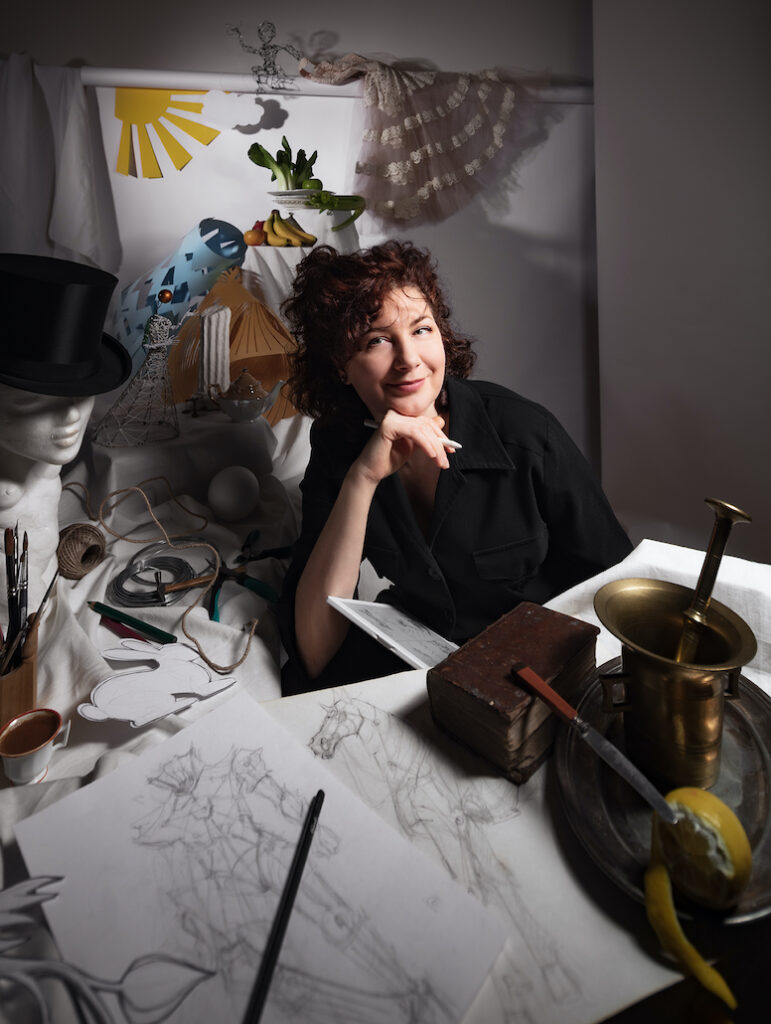
Photo by Jan Prerovsky, Foodly Doodly Doo
Ellen was born and raised in a medium-sized city in Ukraine where chemical and heavy metal factories dot the landscape. She said, “In every direction you point, there is an industrial factory where I grew up.”
Ellen’s early life was consumed by the arts. She studied painting and design in a Fine Arts school and finished her education as a tailor and dressmaker. She did not see her future in a Ukrainian industrial city. In 2000, shortly after finishing her education as a tailor, she got married and emigrated with her husband to Prague.
She then opened a fashion studio with a friend in Prague where they created their own collections and put on fashion shows. Ellen was looking for a photographer to take pictures of their fashions and shows. Her ex-husband reached out to Jan on Ellen’s behalf after meeting Jan by chance at a party in 2004.
“He gave me Ellen’s contact information, and about a week later we met. Over the next four years, we worked together on projects, before becoming a couple in 2008 and then getting married ten years later in 2018. We got married on a Tuesday in a small city called Utery, which is translated as Tuesday,” Jan said.
Collaborating to create a fashion museum
Ellen and Jan are particularly proud of the Prague Fashion Museum and Vintage Store they created together in their early years of collaboration.
Ellen opened a vintage clothing boutique called “Laly” in Old Town, Prague’s medieval settlement, in 2006. In 2012, it became the Prague Fashion Museum and Vintage Store. The designs were all original vintage, museum-quality fashion from the 1920s through the 1980s. The clothes had been mended and repaired if necessary, cleaned and ironed so they were in perfect condition.
The museum separated fashion by decades and exhibited the clothing in context with the political and social events of the respective decade, such as the First and Second World Wars, the Vietnam War, and the rise of dressing for power. The museum also highlighted the respective style, silhouette, and main designers of the decade.
“Jan and I figured out the concept together and opened the only professional fashion museum in Prague,” Ellen said.
“We wanted to show that fashion, as everything else, does not live in a bubble but reflects and is influenced by the political, social, and cultural events surrounding it,” Jan said.
Fashion museum blends Jan's political science education with Ellen's skills as a dressmaker
Having the museum allowed Jan to combine his early philosophies as a political science student with Ellen’s entrepreneurial skills as a dressmaker.
The Prague Fashion Museum and Vintage Store attracted visitors from China and across Europe. Groups of students studying textile design and fashion came to visit and study the exhibitions. Among its many exhibits were the evolution of women’s underwear and the little black dress.
“I particularly remember one group of Dutch students from Rotterdam spending the whole day in our little museum studying it in all detail,” Ellen said.
Ellen and Jan are proud of what they had created together to showcase fashion styles between the 1920s and 1980s, which they believe marked the height of fashion over the past century.
“Fashion today is a repetition of what went before from the 1920s through the 1980s. The styles are slightly different, but fashion in general has had the same fixed styles since the 1980s,” Ellen said.
The museum had to close in 2014 because it was too small to turn a profit. Jan and Ellen had a lot of fun with it, but in the end, it was an expensive hobby they couldn’t maintain. When the museum closed, Ellen began working with Jan in hotel and food photography.
Photos from the Prague Fashion Museum and Vintage Store are archived on Facebook.
We wanted to show that fashion, as everything else, does not live in a bubble but reflects and is influenced by the political, social, and cultural events surrounding it.
Jan Prerovsky Tweet
Filling the void with vegan food styling after fashion museum closes
The Prague Fashion Museum and Vintage Store is gone, but Ellen and Jan’s flat in Prague continues the tradition of housing treasures.
“When I get an idea of what I need for a food sculpture or set design for animation, I always find it and bring it home. One whole room in our flat is reserved for stuff we might need for a project,” Ellen said.
In that room you will find popsicle sticks, table cloths, champagne corks, buttons, balls of string … you name it, and it’s in there. Ellen and Jan collect everything they can imagine, knowing that one day they might need it to create a colosseum, a theater stage, an old medieval city, an abstract backdrop, a surrealist landscape…
“I’m a creator. I always have to find ways to bring new things to creation, especially for vegan food photography,” Jan said.
Finding inspiration everywhere for vegan food styling and vegan photography
Ellen views the world as an expansive arena where body, mind, and spirit come together for creative expression. This makes it doubly difficult for her to pass up finds.
“We find inspiration from everywhere, literally: books, films, exhibitions, and strolls through the neighborhood and on location photo shoots. We can’t pass anything up because maybe I will need it one day for a vegetable sculpture or animated set design, and maybe I won’t. I never know what I will need, so I collect everything,” Ellen said.
The storage room is chock-full of what dreams may come. Anything can happen where the odds and ends are stored and in the room where Jan and Ellen’s dream box resides.
Dipping into the dream box to bring something new to life
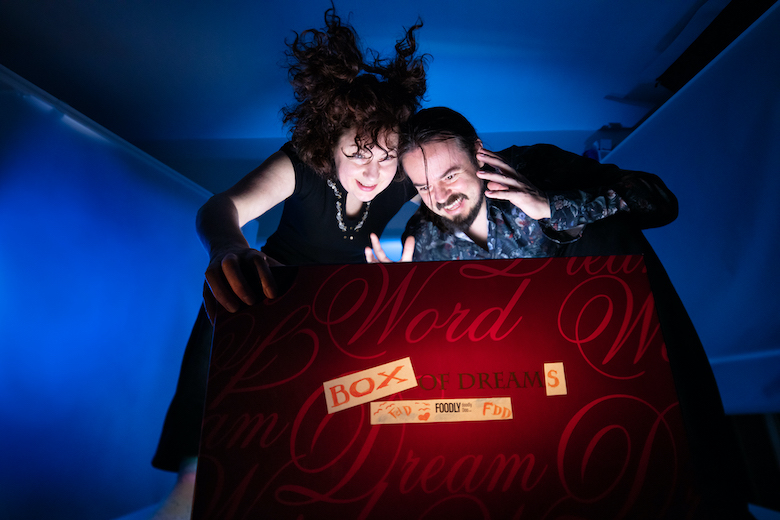
Photo by Jan Prerovsky, Foodly Doodly Doo
Jan and Ellen began Foodly Doodly Doo in 2018 to create a space for their own unique projects, free from restrictions and demands. The dream box is where they keep their rough sketches and notes. They dip into the box when they are ready to bring something new to life.
In frenzied brainstorming sessions, Jan and Ellen tuck their best ideas into the dream box so they don’t float away. The box, brimming with magical ideas for future projects, unleashes every form of creativity when it is opened.
“When we pull our sketches and scribbled notes from the dream box, we see that all of our story ideas would be fantastic to produce. That’s not possible, of course, so we have to let the Muse guide us,” Ellen said.
Behind each of their projects — whether vegan food photography, vegan food styling, vegan food sculpting, or vegan stop-motion animation, and whether on location in other countries with clients, or for themselves in their Foodly Doodly Doo studio in Prague — Jan and Ellen have an invisible force that drives them to excellence.
Each of the vegan food photography series and vegan animation videos found on Foodly Doodly Doo sprang to life after Ellen and Jan plucked the dream box from its perch, lifted the lid, and reached excitedly into the box. From this moment forward, everything is planned in advance down to the last detail and then transferred to a storyboard before they start production.
When we pull our sketches and scribbled notes from the dream box, we see that all of our story ideas would be fantastic to produce. That’s not possible, of course, so we have to let the Muse guide us.
Ellen Prerovsky Tweet
Where art and veganism meet
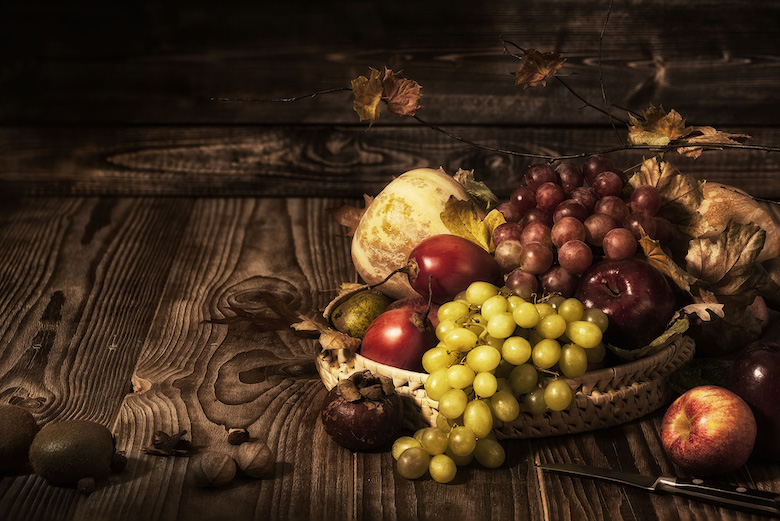
Photo by Jan Prerovsky, Foodly Doodly Doo, modeled after Still life with a dead hare by Jan Baptist Venix, 1703
1. Still Lifes inspired by the Old Masters: vegan food photography series
Foodly Doodly Doo’s vegan food photography series Still Lifes inspired by Old Masters recreates the original paintings of some of Europe’s most renowned artists from the Early Renaissance through to the Romantic movement, roughly from 1300 to 1800.
Jan and Ellen chose some of their favorite paintings by the Old Masters and set out to recreate them precisely through lighting, form, and composition — using a minimum of digital manipulation for color softness or background enhancement or additions. The vegan food artists, however, use no manipulation to alter perspective or composition. Ellen builds each set by hand from scratch, with a little bit of help from Jan.
Their still life photographs were inspired by Giorgio de Chirico, The Uncertainty of the Poet 1913; Salvador Dalí, Still Life Moving Fast 1956; Jan Baptist Venix, Still life with a dead hare ca 1650, and Vincent van Gogh, Nature morte aux poires 1887.
Plant-based foods have inspired artists for millennial
“The colors, textures, and shapes of vegetables and other plant-based foods have inspired many generations of artists long before us. As a photographer, I appreciated the learning element of reimagining and recreating the works of the Old Masters. I tried to walk in their footsteps to see what they might have seen and how they might have overcome obstacles like light and composition,” Jan said.
“And that’s just the visual inspiration. When you talk about taste, nutrition, and health benefits of vegetables and fruits, you have even more to work with as an artist. The storytelling possibilities are endless with still life and other categories,” he said.
“You can learn a lot about composition and light by studying the old masters. We often go to museums and art galleries and spend many hours looking in detail at these paintings. It is also important to know that even they used optics such as the camera obscura as technical aids in order to achieve their masterpieces,” Jan said.
Paintings and photographs have been collaborators as well as competitors; in this way both of these art forms are connected by a special bond,” he said.
2. When Fashion Meets Food: vegan food photography series
When Fashion Meets Food shows the glamor of vegetables. The series came naturally for Jan, a vegan photographer, and Ellen, a dressmaker and vegan food stylist.
Initially, they rendered the series two-dimensionally on dinner plates. The series transitioned onto the 3D plane when Jan and Ellen challenged themselves to make vegetables look like celebrities to suggest people and a world of luxury.
“Vegetables are fascinating. Unfortunately, they have an image problem and are mostly viewed as side dishes in our cultural space. They don’t get the same multi-million Euro marketing budgets that soda and fast food get. With our work at Foodly Doodly Doo, we try to change the image of vegetables by putting them at their rightful place — on center stage,” Jan said.
The vegan pair at Foodly Doodly Doo argues that vegetables should receive more attention than they’re getting. They point out how a diet heavy in meat is unhealthy and medically dangerous, whereas one based on plants can provide the right nutrients for health needs.
Navigating the topic of food, however, can be tricky. Similarly to religion and politics, conversations about food can result in heated arguments and debates.
Food as a sensitive subject
“Diet has a lot to do with our upbringing and what our parents cooked for us when we were little. We automatically take over parts of their habits and preferences and develop an emotional bond to them. It’s very difficult to divert people from their habits, especially when both sides have become entrenched in their positions. When discussions include animal rights, health, and how to deal with our planet, talking about food can get sensitive,” Jan said.
This is where Foodly Doodly Doo comes in. Using humor, they promote the plant-based lifestyle in a fun way, creating interest in vegetables and curiosity about veganism. Above all, the team wants to create positive emotions about vegan food.
If viewers have fun making the recipes at Foodly Doodly Dood and looking at Jan and Ellen’s celebrity vegetables, then maybe the next time they shop for groceries, they will stay a little longer in the vegetable section. That is Foodly Doodly Doo’s hope.
“A cruelty-free lifestyle that respects all living beings is the foundation of a sustainable future. If people eat more vegetables and less meat, then all of our efforts will be worthwhile,” Jan said.
For Jan and Ellen, Foodly Doodly Doo brings together food and art — two worlds that have always been connected. And yet, by switching certain elements through their unique artistry, a whole new vegan perspective arises to visualize the figure of speech “you are what you eat.”
“We are always looking for new perspectives and different angles to tell our story of being vegan. No challenge is too great. And believe me, building these statues and creating fashion images out of vegetables has been a real challenge because we are keen on avoiding post production techniques such as the use of Photoshop as much as possible,” Ellen said.
By giving vegetables a fashionable look, the vegan food stylist and vegan food photographer promote plant based nutrition on a wholly new and exciting level.
3. Vegan Propaganda posters: vegan food photography series
Every day observations frequently inspire Ellen and Jan to create vegan food sculptures that they can turn into studio models and vegan animation characters.
They were inspired again when they noticed how effective vintage propaganda posters were in attracting people’s attention in public spaces. They decided to put their own unconventional spin on posters to create Vegan Propaganda, old posters look new!
Nearly everybody is familiar with propaganda posters with their bold images and catchy slogans like “We can do it!” Jan and Ellen reimagined propaganda slogans and imagery in the spirit of plant based, whole foods, recreating well-known propaganda posters with veggies.
“As usual, Ellen tackled the brunt of the work. She carved, sliced, and diced vegetables, then arranged them with seeds and legumes like a jigsaw puzzle,” Jan said.
The Foodly Doodly Doo team noticed when playing around with vegan propaganda posters that the lines between art and propaganda blur the closer you look. Many of the most renowned pieces of art and craftsmanship, Jan believes, are basically works of propaganda.
Watch the Behind-the-Scenes making of the “Swords to Ploughshares” vegan propaganda poster.
Creating vegan food propaganda
“Think about Alexander the Great putting statues of himself all over his vast empire as well as coins depicting his portrait. Similarly, the stunning images and frescoes we find in churches and cathedrals are undoubtably great pieces of art. But they were made with the clear purpose of spreading and reinforcing a certain ideology,” Jan said.
Ellen and Jan believe good propaganda is good storytelling. There is always an enemy and a hero in every story. The better the story is told, the harder it is to distinguish between the two.
“Making the vegan propaganda posters was quite a challenge, I can tell you,” Jan said. “The most work was probably putting together the last image which is entirely made out of legumes and seeds. Just one slight sneeze and we would have had to have started all over again,” he said.
“As with our other vegan food photography series, our vegan propaganda poster series has not been finished yet. We are just getting started and will keep making new images and continue working on this series and all of the other vegan food photography series,” Jan said.
Making the vegan propaganda posters was quite a challenge, I can tell you,” Jan said. “The most work was probably putting together the last image which is entirely made out of legumes and seeds. Just one slight sneeze and we would have had to have started all over again.
Jan Prerovsky Tweet
4. Fun with recipes: vegan food photography series
Ellen has a natural talent for cooking and creating recipes that she learned from her mother and grandmother. At Foodly Doodly Doo, she draws inspiration from these maternal role models and the Muses in her life who cooked, farmed, and grew vegetables.
“Early in her life, Ellen’s mother and grandmother taught her about vegetables, where they come from, and how to prepare and preserve them. All of these skills combined to make her an excellent cook and fantastic food stylist and art director,” Jan said.
Their vegan video production series Fun with recipes uses photo-storytelling and stop-motion animation to lure viewers into doing what Ellen likes doing most — making healthy vegan recipes.
“I don’t care how well it’s done, no meal will ever be as satisfying or as deliciously nourishing as the one you make yourself,” said Ellen.
Ellen and Jan started the project Fun with Recipes during their transition to a completely whole food vegan diet. The goal of the animated video series was to grab viewers’ attention by showing them how fun food is and how enjoyable it is to experiment with vegan cuisine.
With a bit of whimsy, the team created a fairy godmother who conjures a platter of open-faced vegetable sandwiches using her magic wand. Baked apples blast into outer space, and champagne sorbet is, at its core, a love story about a strawberry and her hopelessly romantic banana beau.
“You just need to listen to food and notice what it is saying through its colors, shapes and textures in order to get the story from it. The ingredients themselves become alive and tell the story.” Jan said.
Vegan food video productions enliven ingredients and animate recipes
Once they choose a recipe to highlight on Foodly Doodly Doo, Ellen puts her skills into practice as a vegan food stylist and sculpts and styles the food. She designs the set that Jan will expertly light and then, with a keen eye toward vegan food photography, bring Ellen’s creations to life through his lens. Ellen will complete the production process and do most of the animating. Together they will complete the project with post-production editing.
With each vegan recipe comes its own cast of glamorous celebrities, bringing luxurious dishes like vegan cauliflower buffalo wings and vegan cherry crumble pie onto center stage and into the spotlight.
Jan and Ellen have only just begun to sift through the ideas stored in their dream box. There will be many more hand-picked and tested plant-based whole foods recipes to come. There will also be many more vegan photography and vegan animation series on the way to Foodly Doodly Doo. So, stay tuned.
“There’s a lot more to come to Foodly Doodly Doo. We are just getting started,” Jan said.
Foodly Doodly Doo's vegan food media productions are meant to inspire and entertain
It’s important to note that in the spirit of sustainability, no food gets thrown away during or after Foodly Doodly Doo’s vegan food productions. Everything gets eaten.
“Although we love to play with our food, we never let it go to waste,” Ellen said.
“Basically, our vegan food media productions are meant for people who are looking for inspiration and entertainment while they are cooking in the kitchen. Of course, our recipes are real, and they are very good ones at that, but this is not the main point of Foodly Doodly Doo,” she said.
Our Fun with Recipes series is meant more for imagination than actual recipes. People who are looking in earnest for a recipe and how to cook it might not find our site to be quite what they are looking for,” Ellen said.
You just need to listen to food and notice what it is saying through its colors, shapes and textures in order to get the story from it. The ingredients themselves become alive and tell the story.
Jan Prerovsky Tweet
5. Stop-motion animation: vegan food photography series
Ellen and Jan had a goal in mind when they created Foodly Doodly Doo in 2018. They wanted to create new looks for vegan foods through entertainment that left an impression long after it was viewed.
To get people interested in vegan food, Jan and Ellen turn vegetables into glamorous models and irresistibly charming characters using their skills in vegan food styling, vegan food photography, and vegan video production.
For them, it’s important to tell stories they want people to hear, without giving away too much information, so viewers can engage their own imaginations.
“We want our audience to feel connected to our stories so they think differently after seeing our work,” Jan said.
As with the vegan food photography series on Foodly Doodly Doo, the vegan food video productions are a labor of love for Jan and Ellen. It takes skill, patience, and a true dedication to the art form to give vegetables human characteristics. To complete their media projects before the vegetables wilt, they often work straight through 24-hour periods.
Building new worlds with stop-motion animation
“We build new worlds and create vegan models with a fashionable look. But we have to work fast and very carefully to finish projects, since these creations don’t stay crisp and fresh for too long under bright lights,” Ellen said.
Stop-motion animation is a fascinating but time-consuming process using toys, food, and other objects to create lifelike images that move. It requires taking hundreds of photos in the same setting.
Jan uses the Canon Eos 1DX Mk2 for his vegan food photography, as well as the Canon 5Ds for stop motion vegan animation. He edits with Adobe software programs, including the video editing program Premiere Pro.
“Ellen and I have always liked stop motion animation, It has a very unique feel to it, a texture and life-likeness which you can’t get with computer generated imagery. Working with fresh food instead of puppets or clay figures gives animation another level of realism and depth.
“We very much love especially the old Soviet Union stop motion animations like “the hedgehog in the fog” or the works of popular Czech filmmaker Karel Zeman because they combine real elements in a kind of surrealistic dream world that has endless possibilities,” Jan said.
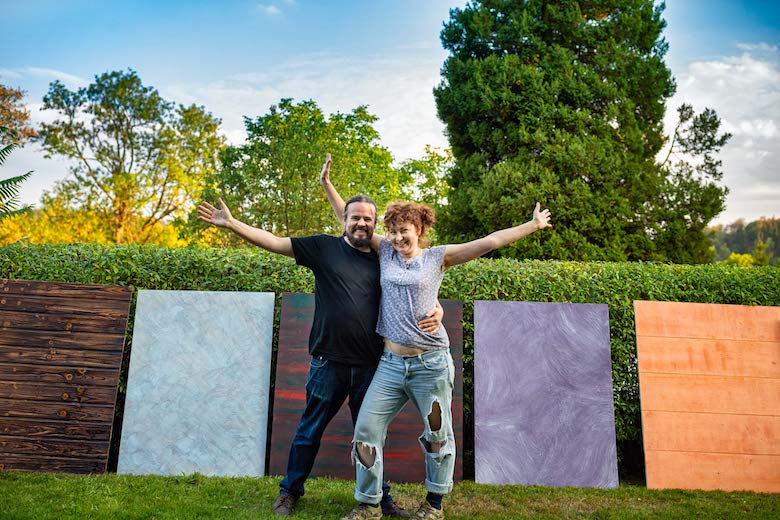
6. Here’s how we did it: behind-the-scenes vegan food photography series
Foodly Doodly Doo’s Behind the scenes vegan food photography animation series reveals through time-lapse photography how Jan and Ellen create their vegan designs.
“It’s fun for us to think that people might look at our Behind-the-Scenes series and wonder about the two crazies in Prague who are making this stuff,” Jan said.
It’s not a stretch for Jan to imagine people watching Foodly Doodly Doo’s behind-the-scenes videos. Viewing bonus features about how movies are made is often more interesting to him than watching the actual film. He believes that people may feel the same way he does and want to see what goes on behind-the-scenes at Foodly Doodly Doo.
“Peeling back the curtain to reveal the film’s creator gives me a sense of connection with the film and enhances my appreciation for it because it shows just how much effort and time went into producing it,” Jan said.
As for Foodly Doodly Doo’s Behind-the-Scenes vegan food photography animation series, the vegan media duo says they have much more material to showcase than they have published to date. Jan and Ellen envision using their animated projects in the future for special edition printed projects and videos to promote veganism.
Creative sanctuary for two vegan artists
Foodly Doodly Doo is a place where magical ideas turn into reality, and where good vegan food gets made. The vegan food photography and multi-media studio is located inside a lovely 1930s building in one of the most beautiful neighborhoods of Prague. Within 50 meters of the studio is a stunning view of the old town with its medieval castle.
“Its perfect,” Jan said, “but in an ideal world, we would have more space for my bulky camera equipment and Ellen’s large collection of stuff she uses for vegetable sculptures and set designs for vegan food.”
As it stands, Jan and Ellen find ways of making space limitations work to their advantage. Based on the philosophy that sometimes less is more, Jan and Ellen agree that working with less enables them to be more expressive and creative by forcing them to think outside the box.
“For example, Ellen said, “Whenever we finish a project with a client, our entire flat is a big mess. Since we live in the same space where we work on projects, we have to tidy up after each shoot. We don’t have any fixed furniture. Everything is mobile here, so we can move things around wherever we need it.”
Jan said, “when I go on a photo shoot with a large case holding 20 lenses, it can be cumbersome and interfere with the assignment. Having just one lens on one camera forces me to figure out a creative way to tackle the assignment.”
Jan and Ellen agree that challenges are what drive them to create new worlds at Foodly Doodly Doo. “We find the challenge behind everything we do to be the most enjoyable aspect of our lives,” Jan said.
Milestones and future vegan projects
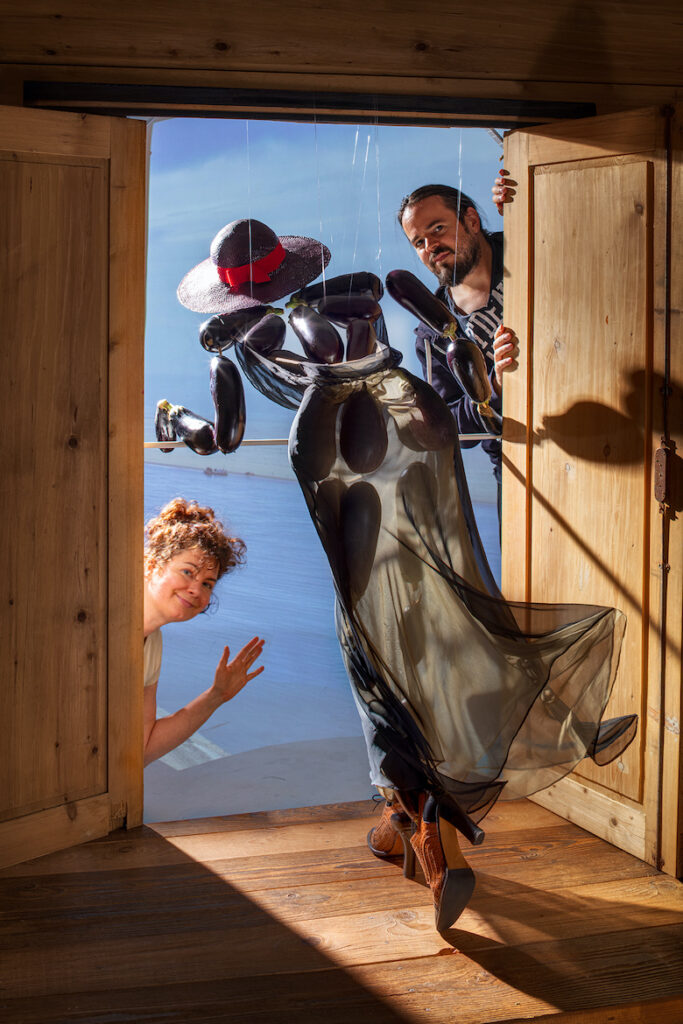
Photo by Jan Prerovsky, Foodly Doodly Doo
The opening of Foodly Doodly Doo’s eShop in February 2022 marked a milestone in its mission to reach more people with the vegan message.
The company is starting with T-shirts, bags, and coffee mugs with a view to expanding in the future. All of the merchandise is 100% vegan and ecologically sustainable. The products are printed in France, packed without plastic, and shipped with a carbon neutral footprint.
The future looks bright for Jan and Ellen as they grow the vegan movement through messaging and media. They are currently developing an educational video series on vegan nutrition. The animated series will be a sequel to their pilot video The Garlic Gladiator.
In the pilot, a garlic bulb is portrayed as a seasoned warrior. He has a gentle tone and weary muscles, like the rest of us after a hard day of work. In order to alleviate his back pain, the gladiator removes his armor to do yoga. The video lists the health benefits of garlic as performs the warrior pose and other yoga asanas.
“The gladiator is not a real warrior who is going to beat people up or kill them. He is gentle and has a Buddhist spirit,” Ellen said.
Learning from vegetables: educational video series in planning stages
In future episodes, Ellen and Jan will present additional lovable vegetables. The continuing series will focus on the problems vegetables face and show how they overcome them through fitness and self-care practice while extolling the virtues of a vegan diet. Foodly Doodly Doo is looking for a sponsor to produce the series.
The call to action for the educational video series is simple. Jan and Ellen want to invite children, teachers, parents, and everyone else to learn from vegetables and to have adventures with them in their kitchens. Along the way, the vegan duo want to highlight the importance of physical exercise in combination with a healthy plant-based diet.
“The combination of exercise and eating vegan is what makes us healthiest. Producing an educational video series on diet and exercise is another way we can help grow the vegan movement. It’s exciting!” Jan said.
Promoting veganism positively through play
The primary reason Foodly Doodly Doo is so unique is that Jan and Ellen combine adult tasks with a youthful perspective. The vegan food photographer and vegan food stylist are playful and joyful when communicating the messages of being vegan. Their productions are uplifting and put us in a good mood. We leave their site feeling energized, entertained, and eager to see more of their work.
“Foodly Doodly Doo is our way of promoting the vegan lifestyle positively through play. We don’t know where the journey will take us, but the main thing is that we are doing what we love!” Ellen said.
Foodly Doodly Doo is our way of promoting the vegan lifestyle positively through play. We don't know where the journey will take us, but the main thing is that we are doing what we love!
Ellen Prerovsky Tweet
Follow Foodly Doodly Doo
Foodly Doodly Doo welcomes collaborations with companies and individuals who embrace the spirit of fun and creativity and want to create something memorable. Visit the website, follow them on social media, or contact Jan and Ellen directly at foodlydoodlydoo(at)gmail.com.
Jan describes Foodly Doodly Doo as a love child. He said, “FdD gives Ellen and me the chance to showcase and develop our artistic visions. But we find a much deeper meaning in what we do that goes far beyond making pretty pictures and amusing animated videos. In our work at Foodly Doodly Doo, we see a chance to do our part in growing the vegan movement.”
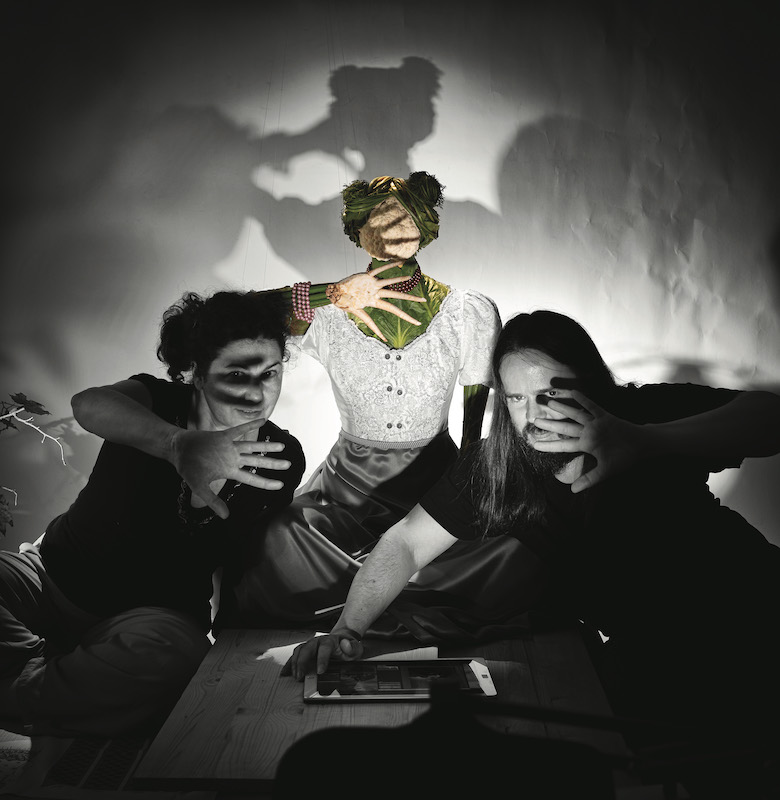
Read next Using food as ARTivism

